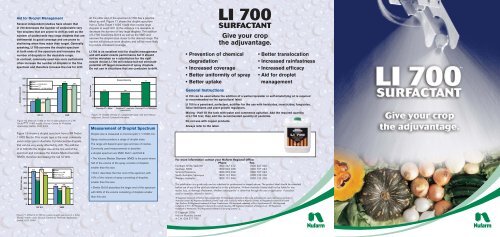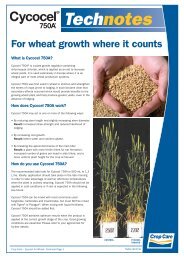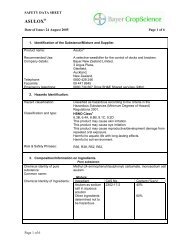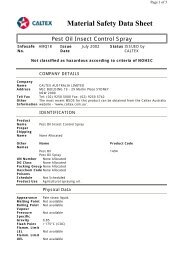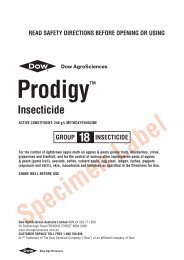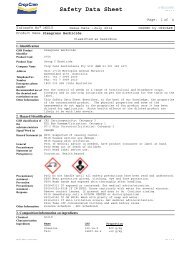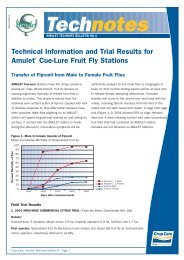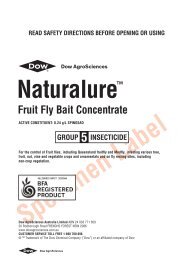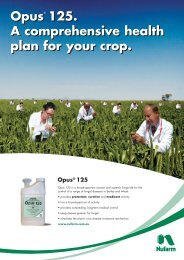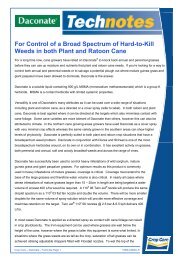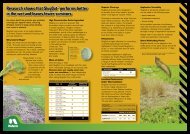LI 700 Technical brochure horticulture - Pest Genie
LI 700 Technical brochure horticulture - Pest Genie
LI 700 Technical brochure horticulture - Pest Genie
- No tags were found...
Create successful ePaper yourself
Turn your PDF publications into a flip-book with our unique Google optimized e-Paper software.
Aid for Droplet ManagementSeveral independent studies have shown that<strong>LI</strong> <strong>700</strong> decreases the number of undesirable veryfine droplets that are prone to drift as well as thenumber of undesirable very large droplets that aredetrimental to good coverage and are prone toshattering when they reach their target. Generallyspeaking, <strong>LI</strong> <strong>700</strong> narrows the droplet spectrumat both ends of the spectrum and increases thenumber of droplets in the desirable range.In contrast, commonly used non-ionic surfactantsoften increase the number of droplets in the finespectrum and therefore increase the risk for drift.At the other end of the spectrum <strong>LI</strong> <strong>700</strong> has a positiveeffect as well. Figure 11 shows the droplet spectrumfrom a Turbo Teejet 11002 nozzle that creates largedroplets to avoid drift. In this instance it is desirable todecrease the number of very large droplets. The additionof <strong>LI</strong> <strong>700</strong> lowers the Dv0.9 as well as the VMD andnarrows the droplet sizes closer to the desired range. Thenozzles will produce more droplets and will be more likelyto provide increased coverage.<strong>LI</strong> <strong>700</strong> is an excellent tool for droplet managementand will assist nozzle performance but it shouldnot be mistaken as a substitution for the rightnozzle choice. <strong>LI</strong> <strong>700</strong> will reduce but not eliminatepotential off target movement of spray droplets.Do not use in situations that are conducive to drift.<strong>LI</strong> <strong>700</strong>SURFACTANTGive your cropthe adjuvantage.• Prevention of chemicaldegradation• Increased coverage• Better uniformity of spray• Better uptake• Better translocation• Increased rainfastness• Increased efficacy• Aid for dropletmanagement®3®1General Instructions<strong>LI</strong> <strong>700</strong> can be used where the addition of a wetter/spreader or self emulsifying oil is requiredor recommended on the agricultural label.<strong>LI</strong> <strong>700</strong> is a penetrant, surfactant, acidifier for the use with herbicides, insecticides, fungicides,foliar fertilizers and plant growth regulators.Mixing - Half fill the tank with water and commence agitation. Add the required quantityof <strong>LI</strong> <strong>700</strong> first, then add the recommended quantity of pesticide.Do not use with copper products.Always refer to the label.Figure 10. Effect of <strong>LI</strong> <strong>700</strong> on fine droplet spectrum of a XRTeeJet ®10 11002 nozzle. Source: Centre for <strong>Pest</strong>icideApplication, Gatton, QLD, 2004.Figure 10 shows a droplet spectrum from a XR TeeJet11002 Nozzle. This nozzle type is the most commonlyused nozzle type in Australia. It produces fine dropletsthat can be very easily affected by drift. The additionof <strong>LI</strong> <strong>700</strong> lifts the droplet size at the fine end of thespectrum and increases the Volume Media Diameter(VMD), therefore decreasing the risk for drift.Figure 12. Droplet velocity of a glyphosate spray with and withoutadjuvants. Source: Loveland Industries.Measurement of Droplet SpectrumDroplet size is measured in microns (μm) = 1/1000 mm.Spray nozzles produce a range of droplet sizes.The range will depend upon type and size of nozzles.Commonly used measurements to describea droplet spectrum are VMD, Dv0.1 and Dv0.9.• The Volume Median Diameter (VMD) is the point wherehalf of the volume of the spray consists of dropletssmaller than this size.• Dv0.1 describes the finer end of the spectrum with10% of the volume of spray consisting of dropletssmaller than this size.• Similar Dv0.9 describes the larger end of the spectrumwith 90% of the volume consisting of droplets smallerthan this size.For more information contact your Nufarm Regional Office:PhoneFaxNorthern NSW/QLD/NT 1800 267 612 1800 267 602Southern NSW 1800 033 038 1800 707 543Victoria/Tasmania 1800 033 038 1800 707 543South Australia/Sunraysia 1800 131 964 1800 133 206Western Australia 1800 131 964 1800 133 206This publication is a guide only and no substitute for professional or expert advice. The product label should be consultedbefore use of any of the products referred to in this publication. Nufarm Australia Limited shall not be liable for anyresults, loss, or damage whatsoever, whether consequential or otherwise through the use or application of productsand/or materials referred to herein.® Registered trademark of Nufarm Technologies USA, ®1 Registered trademark of Monsanto Technology LLC used under licence by NufarmAustralia Limited, ®2 Registered trademark of BASF used under licence by Nufarm Australia Limited, ®3 Registered trademark of UnitedAgri Products, ®4 Registered trademark of Bayer CropSciences, ®5 Registered trademark of Dow AgroSciences LLC, ®6 Registeredtrademark of FMC, ®7 Registered trademark of Loveland Industries, ®8 Registered trademark of Margarita Int., ®9 Registeredtrademark of Montecatini, ®10 Registered trademark of Spraying Systems Co.Figure 11. Effect of <strong>LI</strong> <strong>700</strong> on coarse droplet spectrum of a TurboTeeJet 11002 nozzle. Source: Centre for <strong>Pest</strong>icide Application,Gatton, QLD, 2004.© Copyright 2006.Nufarm Australia LimitedA.C.N. 004 377 780
<strong>LI</strong> <strong>700</strong>®3SURFACTANT - GIVE YOUR CROP THE ADJUVANTAGE<strong>LI</strong> <strong>700</strong>Surfactant – Penetrant – Acidifier – Aid for Droplet ManagementMore than 200 adjuvants are registered in Australia. Many of them have little or no empirical datasupporting their label claims. In contrast, <strong>LI</strong> <strong>700</strong> is one of the most researched adjuvantsin the world and its multifunctional properties are well understood.<strong>LI</strong> <strong>700</strong> is made from a blend of Lecithin oil, propionic acid (a weak organic acid) and varioussurfactants. This combination of ingredients gives <strong>LI</strong> <strong>700</strong> a wide range of properties that can greatlyenhance pesticide performance in several ways.Spreading and wettingThe majority of pesticides prefer a slightly acidic milieuin the range of pH 6 or less. Some plants, especiallybroadleaf weeds have surfaces that are naturally highin pH (alkaline) that hinders the uptake of weak acidicpesticides. The acidifying properties of <strong>LI</strong> <strong>700</strong> helpto create a more favourable pH environment for thepesticide on the leaf surface. With its penetratingproperties <strong>LI</strong> <strong>700</strong> enhances speed and overall uptakeof products and increases efficacy and rainfastness.Enhancement of RainfastnessFor example, in a trial conducted in citrus <strong>LI</strong> <strong>700</strong>enhanced the uptake of manganese, zinc and iron(Figure 2). There was no effect on copper uptake.Copper products generally prefer a higher pH and shouldnot be mixed with <strong>LI</strong> <strong>700</strong>.In a different trial in citrus <strong>LI</strong> <strong>700</strong> increased the uptakeof foliar urea when compared to the use of a non-ionicsurfactant (Figure 3). The indirect urea uptakemeasurement of chlorophyll reading shows an increase inphotosynthetic activity shortly after application.Without adjuvant Cycocel showed limited uptakeand movement. The treatment containing <strong>LI</strong> <strong>700</strong>demonstrated the best uptake, resulted in the besttranslocation and was the only treatment whereCycocel moved down to the base of the leaf.Another PGR extensively used in table grapes isGibberellic Acid (GA). Trials indicate that at low<strong>LI</strong> <strong>700</strong> rates of 0.08 - 0.125% the use of <strong>LI</strong> <strong>700</strong>increased the uptake of GA, resulted in better sizedberries and less compact bunches (Figure 8 and 9).No crop effect was observed.<strong>LI</strong> <strong>700</strong> reduces the surface tension of spray droplets, allowing them to spread over a greater surfacearea which greatly increases coverage. In this regard <strong>LI</strong> <strong>700</strong> is not different to a typical adjuvant.<strong>LI</strong> <strong>700</strong> does more. Its acidifying properties protect many pesticides from chemical degradation in thetank and provide a more favourable pH environment on the leaf surface for their uptake. Itsmultifunctional chemistry opens cuticle pathways in the waxy layer of the plant and increasespenetration and translocation to the target sites.II7Figure 5. Apples - changes of calcium levels of Cox Orange aftercalcium chloride treatment. <strong>LI</strong> <strong>700</strong> at 0.3% v/v.Source: Geelen, 1997.The uptake of boron was increased in Broccoliwhen Borosol was used with <strong>LI</strong> <strong>700</strong> (Figure 6).Chemical HydrolysisAlkaline hydrolysis is the chemical break downof pesticides in spray solutions that can occur if the waterused for spraying is alkaline. In Australia, most water usedfor spraying has varying degrees of alkalinity. Alkalinehydrolysis is affected by the susceptibility of the product,the pH of the water, duration of contact and temperature.A most alarming example of rapid breakdown is theinsecticide dimethoate. It loses half of its activity in only45 minutes when mixed with water pH 9. Table 1 showssome examples of pesticides affected by alkalinehydrolysis. Minimising breakdown can be achieved byacidifying the spray solution with <strong>LI</strong> <strong>700</strong> to the optimumpH level of 4 to 6. Unlike other acids that can over acidifythe spray solution, the propionic acid in <strong>LI</strong> <strong>700</strong> is a weakacid that will not lower the pH beneath the safe levelof pH 3.5. This becomes especially relevant for a dropletdrying on the leaf surface. As the water is evaporating theconcentration of acid will increase. Droplets containing<strong>LI</strong> <strong>700</strong> will remain buffered at a safe pH level around 3.5.PenetrationAt rates of 250 mL/100 L and above the lecithinchemistry temporarily loosens the joints betweenoverlapping wax plates on the leaf surface. This enhancesthe uptake of herbicides, foliar fertilisers, fungicides andplant growth regulators. Unlike many other oils thedisruption of the waxy layer by <strong>LI</strong> <strong>700</strong> has little sideeffects. The cuticular disruption by <strong>LI</strong> <strong>700</strong> is onlytemporary and the wax will reset to near normal(Picture 1). Therefore, in many horticultural situations<strong>LI</strong> <strong>700</strong> is soft on the crop when compared to otherpenetrating adjuvants.Normal structureundisturbedStructure after exposureto petroleum oil-basedadjuvantStructure after exposureto <strong>LI</strong> <strong>700</strong>Figure 1. Wild radish, effect of <strong>LI</strong> <strong>700</strong> on rainfastness of Glyphosate450CT at 1.2 L/ha. Source: A. Wells, Plant Protection QuarterlyVol 4(4) 1989.Faster penetration into the plant means less exposureto detrimental weather conditions. This effect of <strong>LI</strong> <strong>700</strong> isdemonstrated in Figure 1. <strong>LI</strong> <strong>700</strong> aids in the quick uptakeof glyphosate into the waxy layer of radish and increasesthe rainfastness dramatically. In the same study similarresults were observed on wild oats, annual ryegrass andhedge mustard.Increase in Uptake of Foliar Fertilisers<strong>LI</strong> <strong>700</strong> enhances the uptake of foliar fertilisers in a widerange of horticultural crops. Trials have shown improveduptake of iron, zinc, manganese and boron whenformulated as salt, chelate or sulphate.Figure 3. Citrus - increased uptake of foliar applied urea.Source: Yuma, 1998.Especially the uptake of manganese benefits from the useof <strong>LI</strong> <strong>700</strong> as a further trial in onions shows (Figure 4). <strong>LI</strong><strong>700</strong> increased the uptake of the chelated formulation aswell as the sulphate form.Figure 4. Onions - increased uptake of manganese into plant whenapplied as a chelate or sulphate foliar application. <strong>LI</strong> <strong>700</strong> at 0.5% v/v.Source: Asselin, 1999.Figure. 6. Broccoli - increased uptake of boron. <strong>LI</strong> <strong>700</strong> at0.5% v/v . Source: Fafard, 1999Translocation<strong>LI</strong> <strong>700</strong> does not only affect the uptake of chemicalsinto the plant but also their translocation inside theplant. For example, Cycocel ®2 77A (chlormequat)a Plant Growth Regulator (PGR) for grapevines haslimited mobility in the plant. Figure 7 shows theresults of an experiment in which chlormequat wasonly applied to the middle of a cereal leaf.Figure 8. Table grapes - increased berry size in ThompsonSeedless. Source: Loveland Industries.Figure 9. Table grapes - increased stem and branch length inThompson Seedless bunches. Source: Loveland Industries.Dimethoate, Rogor® 9 , Sabotuer®Bugmaster® 4Imidan® 8Kelthane® 2Dipterex® 4 , Lepidex 500Fastac®Duo, Dominex®Rovral®Picture 1. Annual ryegrass (Lolium rigidum) waxy cuticular.Figure 2. Citrus - increased foliar trace element uptake with <strong>LI</strong> <strong>700</strong> at1.4 L/ha, Zn-Mg 18x15 at 5.6 kg/ha, MKP(0-52-34) at 11.2 kg/ha.Source: Gless, 2000In apples <strong>LI</strong> <strong>700</strong> increases the calcium concentration infruit and leaves when used with calcium chloride (Figure5). No phytotoxic effect was observed. When comparedto standard non-ionic surfactants the increased uptake ofcalcium resulted in a significant 24% reductionof bitter pit.Figure 7. Effect of <strong>LI</strong> <strong>700</strong> on uptake and translocation ofchlormequat in a wheat leaf. Source: University of Essex.


